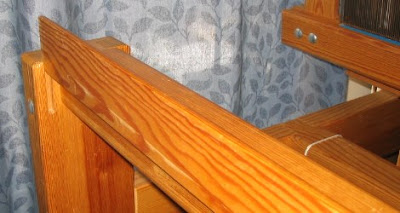Donna was curious about the cloth protector on my loom, so these photos are for her. I had never heard of a cloth protector (aka cloth cover board) until I got this loom. In fact, if it hadn't been for the Glimakra set-up video I might not have realized what it was. Here is a shot that shows it in use. You can see that it is attached in front of the breast beam.

You can click on the photo to biggify the image. On my loom, there are slots in front of the breast beam on both sides, shown below.


The cloth protector simply slides down into these slots. Obviously this is done after the front apron rod has passed over the breast beam.


I think it is very beneficial for wide projects. I tend to tuck the bench up under the loom as far as I can when I weave, and this results in leaning on the fresh fabric as I throw and catch the shuttle. The cloth protector protects it from my leaning and possibly rubbing against the cloth.
Speaking of width, Marie asked about the width of my loom and the afghan. The widest I can weave on this loom (a Glimakra Standard) is 59 inches. The warp's width in the reed for my afghans has been 44 inches. After they're off the loom and have been washed, they are 38 inches wide. My digital camera may have something to do with how huge they look on the loom!
Charleen asked how I like weaving those wider fabrics. I have to say, better than I thought I would. I'm not sure that I would have chosen such a wide loom, except that it came up for sale at the right time. Now however, I'm delighted with the possibilities. True, I do have to stretch more to throw and catch the shuttle, but I chalk that up to "exercise." One thing that has taken some getting used to is that the beater has to be pushed back and held open for the shuttle to pass through the shed. This is because the Glimakra has a hanging beater, so I am always working against gravity. I understand that it is possible to get such a rhythm going that one can weave quite fast as the beater swings back and forth. I don't expect to get to this speed anytime soon however :)
Lastly, Cathy was interested in how I tie on new warps. I promised her that I will take photos of the process when I start my next Christmas afghan.
Hopefully I got everything answered. Next up will be another alpaca project!
Speaking of width, Marie asked about the width of my loom and the afghan. The widest I can weave on this loom (a Glimakra Standard) is 59 inches. The warp's width in the reed for my afghans has been 44 inches. After they're off the loom and have been washed, they are 38 inches wide. My digital camera may have something to do with how huge they look on the loom!
Charleen asked how I like weaving those wider fabrics. I have to say, better than I thought I would. I'm not sure that I would have chosen such a wide loom, except that it came up for sale at the right time. Now however, I'm delighted with the possibilities. True, I do have to stretch more to throw and catch the shuttle, but I chalk that up to "exercise." One thing that has taken some getting used to is that the beater has to be pushed back and held open for the shuttle to pass through the shed. This is because the Glimakra has a hanging beater, so I am always working against gravity. I understand that it is possible to get such a rhythm going that one can weave quite fast as the beater swings back and forth. I don't expect to get to this speed anytime soon however :)
Lastly, Cathy was interested in how I tie on new warps. I promised her that I will take photos of the process when I start my next Christmas afghan.
Hopefully I got everything answered. Next up will be another alpaca project!
© 2007 Leigh's Fiber Journal
6 comments:
I remember reading Laura Fry's comment on WeaveTech that good selvedges come as you establish your rhythm. IYour selvedges look great! You must have a steady enough beat. (I answered your question on my blog.)
Leigh, I am so grateful for your clear explanations and excellent photos. A picture is really worth a 1000 words!! I don't know how it will be done, but I hope to incorporate a cloth protector board when the Cranbrook is brought into use. Your photos will be of great help! Thank you!
Sharon, come to think of it, I reckon I did develop a rhythm. It was just super slow!
Donna, I'm so happy to help. Glad to know I posted useful photos! I hope you keep us posted about the progress on your Cranbrook.
Leigh,
Wow! In a million years I wouldn't have dreamed this blanket is Red Heart! It looks lovely, and you've done a stellar job weaving!
My loom also has the cloth protection bar. It's a great idea, isn't it? And over the years I have developed a rhythm with my hanging beater and much prefer it to the underslung beaters on all my other looms.
Thank you for that Brenda. Right now I feel like it will be impossible to develop a rhythm, but I won't give up on it.
Okay, so if I say I really like the colours in that blanket, does it make me masculine? :-) Nice work, Leigh!
Post a Comment